
WebLetter 15
An Occasional Publication for the Home Boat Builder
Glen-L Marine Designs - 9152 Rosecrans Ave. - Bellflower, CA 90706
|
Happy Holidays
1999 |
In this issue
- Builder Feedback: Roustabout
- New "Sailboat" pages on site
- "Rigging Small Sailboats"
- Making a model from Glen-L plans
- New Books on site
- Feedback: Power Skiff 14
- Recent email
Glen-L Update
Website:
- New "Sailboat" pages added to site. See below.
- As always, the Project Registry, Boatbuilder Connection, and Customer Photos pages have grown.
- The PowerYak test model is finished and additional photos have been added to the "New/On the drawingboard" page. The boat worked exactly like it was supposed to and is my new favorite boat. I'm not a speed demon, and prefer the quiet of a rowboat or electric boat. For those of a like mind, it's almost here. The plans are currently being proofread and will be ready within a month. Since it should be available before the next WebLetter, keep an eye out for the new "Special Purpose" design pages, it will be there.
- We make frequent small revisions to pages in response to customer input. If you see anything wrong on our site, let us know.
We have suddenly become very busy at Glen-L. It's time for the 2000 version of our "hard copy" catalog, and we have to prepare the photos and copy for printing. We are also getting the new "Special Purpose" pages ready for the web site; which will be followed by "Outboards". We are reaching the final stages of production of new videos on Electric boats, and the warehouse needs a new roof. As mentioned above, everyone is proofreading portions of the instructions, plans, or patterns for the PowerYak. Oh, and of course, this WebLetter.
Glen-L Boatbuilder T-shirts and caps are now available. Thanks to all of those who gave us design input. See the Boatbuilding Supplies pages for more information.
When we write about building boats, many people make a mental comment, "yeah, but they are boatbuilders, what about us amateurs?". Your comments and articles let other potential builders know that they can do it. Won't you share your experience with other builders? We are looking for articles, boat building hints, and photos for future WebLetters. How about "Shop Talk" about a particular procedure, special jigs you have made, or the right tool to use?
The staff of Glen-L would like to thank all of our
customers
for making this a special year and wish you all a great
holiday season.
Barry Witt
Editor
Builder Feedback: Roustabout
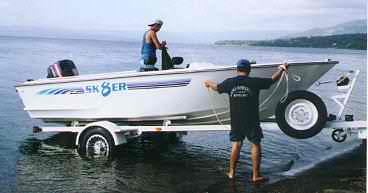
Subject: Project Registry
Date: Thu, 9 Dec 1999
From: Teodoro M. Panganiban
ROUSTABOUT/ Teddy Panganiban/ Quezon City,Philippines/
12-5-1999: Finally went on sea trial today at Taal Volcano
lake about 80 kilometers south of Quezon City. Rains and high
humidity delayed the painting of the the boat. I used a two
part polyurethane white paint and clear top coat which is
picky with the weather. The trailer (assembled from a Glen-L
plan) worked fine although I did not drive my minivan beyond
80 kilometers per hour. The boat reached speeds of 63 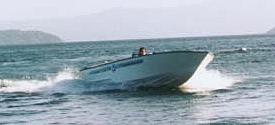 kilometers per hour (@5000 rpm) for a few
seconds since I am still breaking-in the Evinrude 115. I used
a Magellan 2000 XL GPS to measure the speed. I am using a
14" x 19 pitch prop. I also tried a 14" x 17 pitch
but there was slight over-revving. The lake was choppy all
day with about two foot waves. The deep V hull did its job
cutting through the white caps but it felt like riding a
galloping horse at the helm. Will officially pop the
champagne this coming weekend and send you the pictures. Additional Photos
kilometers per hour (@5000 rpm) for a few
seconds since I am still breaking-in the Evinrude 115. I used
a Magellan 2000 XL GPS to measure the speed. I am using a
14" x 19 pitch prop. I also tried a 14" x 17 pitch
but there was slight over-revving. The lake was choppy all
day with about two foot waves. The deep V hull did its job
cutting through the white caps but it felt like riding a
galloping horse at the helm. Will officially pop the
champagne this coming weekend and send you the pictures. Additional Photos
New Sailboat pages on site
Our on-line Boat Design Catalog is gradually being revamped. Boats for "Rowing", "Paddle" and now "Sailboats" have been re-formatted and additional features added. These pages now have links to a Bill of Materials for the design, and in some cases, additional line drawings. We hope to eventually re-format the whole catalog, but it is a very slow process. Very few of the Bills of Materials are in electronic format and must be typed. Eventually we hope to add a "Notes" page for each design which will include additional information. We hope you will visit these pages and send us any comments or suggestions.
The next section to be re-formatted will be "Special Purpose" boats, due in about two weeks.
Rigging Small Sailboats
In response to inquiries about an out-of-print book published by Glen-L, we are starting a series in our WebLetters, reproducing Rigging Small Sailboats. This issue contains Chapters 1 and 2; to be continued in the next WebLetter.Chapter 1
.....introduction
This book is a basic "how-to" guide for rigging modern single masted sailboats up to about 25' in length. Any person building his own small sailboat, buying a new boat, or one who already owns a boat and wants to replace or change the rig on his boat will find this book valuable. We have attempted to write the book so it can be easily understood by both the beginning sailor as well as the "old salts". However, if you are looking for a "how-to-sail" book, or a book on competition "tuning and racing", or a book on "sailing theory," then this is not the book for you. What is here is practical information on basic rigging and how to install it.
Rigging means putting the spars and related equipment in position so the boat is ready for sailing. Rigging also means these items as a functional unit once installed in the boat and made operational. Many terms used herein may sound strange to the beginner and appear to have no relation to the part they describe. Also, many of these terms have no similarity or counterparts to terms used on shore. Nevertheless, they are necessary to the business at hand. Important terms that you should know are initially noted in BOLD type and will be defined where they first appear, as well as in the glossary. Don't try to remember them all once, because after you see them a few times, you'll be able to relate the term to the function, and soon it will become second nature.
The book is arranged in a logical sequence. PART I concerns mainly the definition and function of the various equipment used in rigging. PART II is the practical "how-to" section on rigging sailboats. All illustrations are noted by a "Figure number", the first number listed referring to the chapter. With the basic information presented, we think you will be able to completely outfit and rig your sailboat with ease and confidence. We have purposely limited the scope of this book so as not to overwhelm the beginner, and yet provide useful information to the large majority of small boat sailors; those who sail the modern rigged boats under 25' in length.
Making a model from Glen-L plans
Many builders build models before the real thing. We have recently had several emails from a school class on how to make models, so I thought I would share my recollection of making a model of the TNT (10 years ago).
Most Glen-L plans have scale drawings of the frames and stem of the boat. While we would not recommend making a full-size boat from these drawings they work fine for making a model. (Click here to see a portion of sheet 3 of 3 of the TNT plans.)
The TNT plans are 1 1/2"=1' scale (larger boats are typically 1" = 1'). I made my TNT model 16 1/2" long using the frame drawings as patterns. All spacing and other dimensions were measured using a draftsman's scale (1 1/2" = 1'), so I had no problem converting dimensions. I used balsa wood from a local hobby store as my building material, and white glue with straight pins to hold the pieces in place until the glue had set. The doing was more involved than the above description would indicate. A building form was still required; I used the instructions and plans to make the form and for the "how-to" of installing the longitudinals and fairing. By the time the model was finished, I had gone through all the procedures I would have to use in building a real size TNT. There are other more "professional" ways to go about making a model, but for my purpose, this method worked fine.
Although I have not tried it, you should be able to use a copy machine to enlarge the plans to change the scale, as long as all components and longitudinal dimensions are enlarged the same amount.
Plans only (without patterns) for most designs can be purchased for half the price of the plans and patterns. A few of the smaller designs do not have these drawings, so if you plan to make a model using the above method, check with us to see if the plans have the proper details.
I would welcome any feedback from builders who have built a scale model, on what procedure they used.
New books on site:
Our email load is still increasing and, in self-defense, we have been searching for books that answer difficult-to-answer-in-500-words-or-less questions. The following books have been added to the Boatbuilding Books pages.
- LOFTING by Allan Vaitses. This was one of our most popular books until it went out of print. Well, now it's back and Glen-L's got it. Although our plans don't require lofting, many of you want to know more about it, so here it is.
-
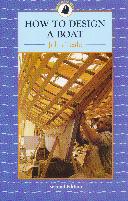 HOW TO DESIGN
A BOAT by John Teale. It surprises me how many people
want to know more about designing boats. This book really
apeals to me, mostly because its only 156 pages long and
it is only $17.95. There are design books available that
are much larger and much more expensive, but I doubt that
most amateurs would read them. This book is a great
introduction and will answer most questions the amateur is
likely to ask. "John Teale makes boat designing
fun... Thoroughly recommended." - Motor Boat &
Sailing
HOW TO DESIGN
A BOAT by John Teale. It surprises me how many people
want to know more about designing boats. This book really
apeals to me, mostly because its only 156 pages long and
it is only $17.95. There are design books available that
are much larger and much more expensive, but I doubt that
most amateurs would read them. This book is a great
introduction and will answer most questions the amateur is
likely to ask. "John Teale makes boat designing
fun... Thoroughly recommended." - Motor Boat &
Sailing
- SAILS by Derek Harvey. You want to make your own sails? Apparently, so do a lot of other people. This is a compact book, with a lot of information. There is also a coupon in the book to request free "Sailmaster" software.
- ALL ABOUT CRUISING by Walt Gleckler. This book is for those who wish to sail off into the sunset on extended cruises. When anyone starts discussing this possibility, I recommend that they get all the information they can. The sea can be a thoroughly nasty place, and you want to be prepared. This is a great book to help you plan your cruise. "...few have dealt with this vast subject so clearly and imaginatively as Walt Gleckler. An instant classic!" - Jimmy Cornell, author of World Cruising Routes.
Feedback: Power Skiff 14
Glen-L,
Attached please find some pictures of my recently finished
Power Skiff 14'. I ordered the plans in October '98
and finished the boat in August '99. I built the boat in
my garage in my spare time and enjoyed every minute of it. I
never thought building a boat could be so much fun and
rewarding. I modified the original plans by installing a
console ( in 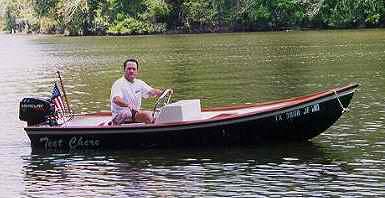 order to have remote steering) and
an additional seat. The extra work really paid off...
she's a joy to drive. I have received more compliments
than I ever imagined. Many people have asked if it's a
refurbished old boat and I proudly respond by saying,
"No, I built her from scratch."
order to have remote steering) and
an additional seat. The extra work really paid off...
she's a joy to drive. I have received more compliments
than I ever imagined. Many people have asked if it's a
refurbished old boat and I proudly respond by saying,
"No, I built her from scratch."
Thanks Glen-L, for all your help along the way by allowing me to bounce ideas off of you and by answering all my questions during the building process. This was my first boat building experience, but I'm sure it won't be my last.
Sincerely,
Brian D. Pierce
Houston, TX
Recent email:
Subject: Squirt Site
Date: Tue, 02 Nov 1999
From: moose
Hi,
I am in the process of building a Glen-L Squirt and have also
created a webpage. I'll be adding to it as I build the
boat. Here's the link:
http://www.overland.net/~moose/squirt_main.html
Would it be alright to post the URL in your boat builders connection so that other Squirt builders, or people thinking about building one can see it?
Thanks,
Steve
name: Michael Abercrombie
City: Eureka
State: Ca
Comments: my first boatbulding project was a Glen L 12 I
built in 1984. In 1988 I bought Amigo fg plans. Today she
sits in my backyard ready to launch !!!
I am waiting for a slip at our new marina to be completed.
Both Glen L designs have been very enjoyable to build. I am
very excited to see my 10+ year project on the water! But I
will miss seeing her in my backyard, What a beautiful shaped
boat.
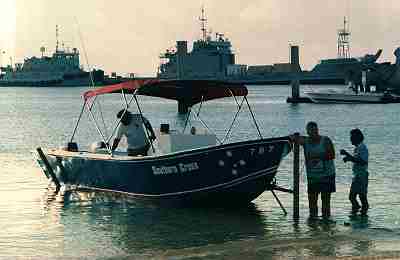
Bill Lovelock
San Diego, CA
Dear Glen L,
I just had a second V-Dory built in the Philippines using the same Glen L plans I used to build my boat in the Marshall Islands a couple of years ago. Photos of the V-Dory I built on Kwajalein Atoll are in the photo archives of your web site and I continue to receive email requests for information about the boat. Unfortunately, when it was time to leave Kwajalein, it was impossible to ship the boat so I was forced to sell it and build another one in the Philippines.
In the Philippines, I was able to employ local boat builders at a very reasonable cost. I hired a man and his three grown sons from a neighboring village. They had built many bancas - the traditional Filipino boat, but never a "speedboat". A banca starts with a type of log known as tongili. It is very heavy and rot resistant and is used to form the bottom of the boat. The banca itself is canoe shaped with plywood sides and has a large bamboo outrigger on either side of the boat. They are generally propelled with very noisy air cooled Briggs and Stratton motors which are available up to 18 horsepower. The boats are reasonably fast and extremely fuel efficient, but the noise from the motor can be deafening if you're not used to it. The same boat was fitted with a sail in older times and called a paraw. They are fast on the wind, but do not point very well and can be turned over fairly easily in a sudden gust- I learned this the hard way!
Anyway, back to the V-Dory. The boatbuilders did not speak very good English and had never used plans or power tools to build a boat. It was quite amusing at times drawing pictures in the sand and gesturing to make them understand how to follow the plans. The transom on the V-Dory is made from a single sheet of plywood, but it must be cut down the middle and the end sections glued and butt joined together. There was considerable arguing in their local dialect among themselves about how to get the transom out of one sheet of plywood. When I was finally able to explain how this was done, they were amazed and I could see the lights come on in their heads.
I had taken some basic electric and rechargeable power tools with me for them to use. At first, they were afraid and a little suspicious of them. After giving them instruction and safety lessons, they finally accepted them and were amazed at being able to drill holes with one drill and drive screws with another. They also liked the electric sanders, but I noticed they still preferred to saw by hand most of the time rather than use the circular saw. These guys were very good carpenters and the finished boat really came out well. We put a layer of fiberglass cloth on the outside of the hull and they were impressed with the results. This was their first experience with fiberglass and they were glad to be learning how to apply it. I am now searching for an outboard motor to ship to the Philippines to power the boat with.
This V-Dory will also be used for fishing-primarily trolling and bottom fishing. The locals currently go out on dark nights and set nets in the ocean. I am amazed at the number of marlin, sailfish, and big tuna that they bring in. I plan to introduce sportfishing there and have built a small resort with overnight rooms and restaurant facilities. This year I plan to build a second V-Dory there and if all goes well even a third one. These boats are easy to build and economical to maintain and make excellent seaworthy fishing vessels. I cannot say enough good things about the design. Thanks for designing such a functional boat.
Best Regards,
Bill Lovelock
Note: There is a follow up letter and photos in Customer Photos/Archives/V-Dory, Lovelock.
Subject: Completed "Sissy-do" (CATFISH) for your
project photos......
Date: Fri, 22 Oct 1999
From: James Brackeen
I finished my Sissy-Do on Easter Sunday '97. There are several differences from the original plan. For durability, I used 1/2" sides and 3/4" bottom all A-B grade marine plywood. All the frames are red Luan. The transom I made a double thickness plus the motor board. As I looked at the seat detail I decided that A) They wouldn't hold up to my abuse and B) They looked rather plain. I was lucky enough to find a local funiture manufacturer that used a lot of oak. I asked the owner for access to his scrap bin and was rewarded with some large bundles of 3/4"x1" trim strips (cut nice and straight too). These strips were then epoxied together using a graphite powder for a binder to get thin black lines for a decorative touch. Planed, sanded, and routed, they were then mounted to some heavy duty seat frames (I dont know anyone less than 200 pounds). The inside of the boat is finished with 3 coats of sealer and sanded smooth (to you rookies: don't sand your plywood until you are ready to paint because the lighter colored grain on Douglas-fir panels is very soft and is sanded easier than the dark grain resulting in depressions that do not look very good - this was a big mistake on my part as far as appearance goes, I no longer sand any panels until a coat or two of sealer is already applied to lessen the problem. Also, too coarse of sand paper can cause this. I then applied three coats of high gloss spar polyurethane. It dries fast (1 day), but not quite as durable as varnish (I found traditional varnish a pain to work with) and you can put it on thick.
The outside of the hull I finished with Interlux Brightside polyurethane system (sealer, primer and paint) in Sea Green. Another modification I made was to add a 3/4"x1" strip with a v-groove on the bottom for a spray buster (a very dry ride now). I added this strip because, while planing at speed, the spray was hitting the bottom of the bumper rail and the wind would soak me with spray. All fittings are either bronze or brass (couldn't find a bronze bow eye- anyone got a lead on one?).
Accessories include a Bimini, downrigger, fishing pole holders, battery, running lights, bilge pump, power socket, fishfinder, gps and a hydrofoil wing on the motor.
Having had 10hp on my last boat and, in consideration of logs, sandbars, submerged trees and rocks as well as the large amount camping gear I have and the size of my friends, I boosted the horsepower to 15. Now you know why all the reinforcements to the hull. She'll do 30mph on smooth water. Waaaay kool.....dude!
In summary, this is an excellent flexible design that was a good choice for a first build. Simple and durable, this boat has withstood some extreme duty in the Lower Colorado River and the kelp beds off of San Diego (2-3 miles outside the bay). It took about two years as a hobby project. I have been offered $3,500 cash by a man from Canada. NO SALE! Not yet...
Please excuse the quality of these photos as my scanner isn't very good. (See Customer Photos/Archives/Sissy Do)
Thanks-J.B.
Subject: BERKELEY JET DRIVES
Date: Wed, 15 Dec 1999
From: CP Performance
To whom it may concern,
This is a note to inform you that Berkeley Jet Drives are
back and in production. Most parts are new castings as we are
constantly improving the molds to meet today's high
standards in the marine industry. If you would like more info
please contact me or check our web sites.
Thanks,
Rick
CP PERFORMANCE
WEB cpperformance.com AND berkeleyjet.com
Subject: Cabin Skiff
Date: Wed, 15 Dec 1999
From: Ray Macke
Barry,
If you are interested I have updated my Cabin Skiff web page. The new info is http://egyptian.net/~raymacke/
Ray Macke
Note: This is a really nice page. If you are interested in the Console or Cabin Skiff, this page is worth a visit.Build more boats
Glen-L boats, of course